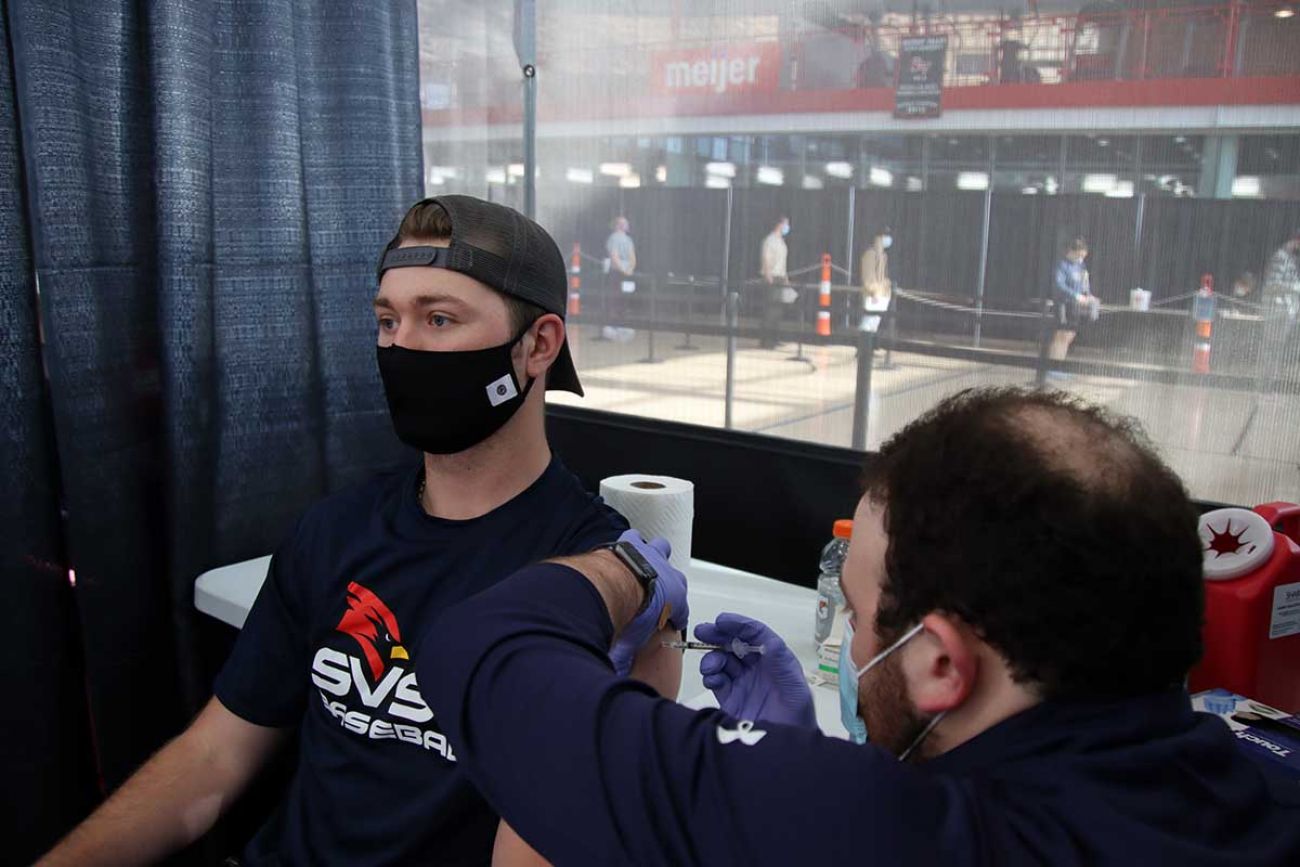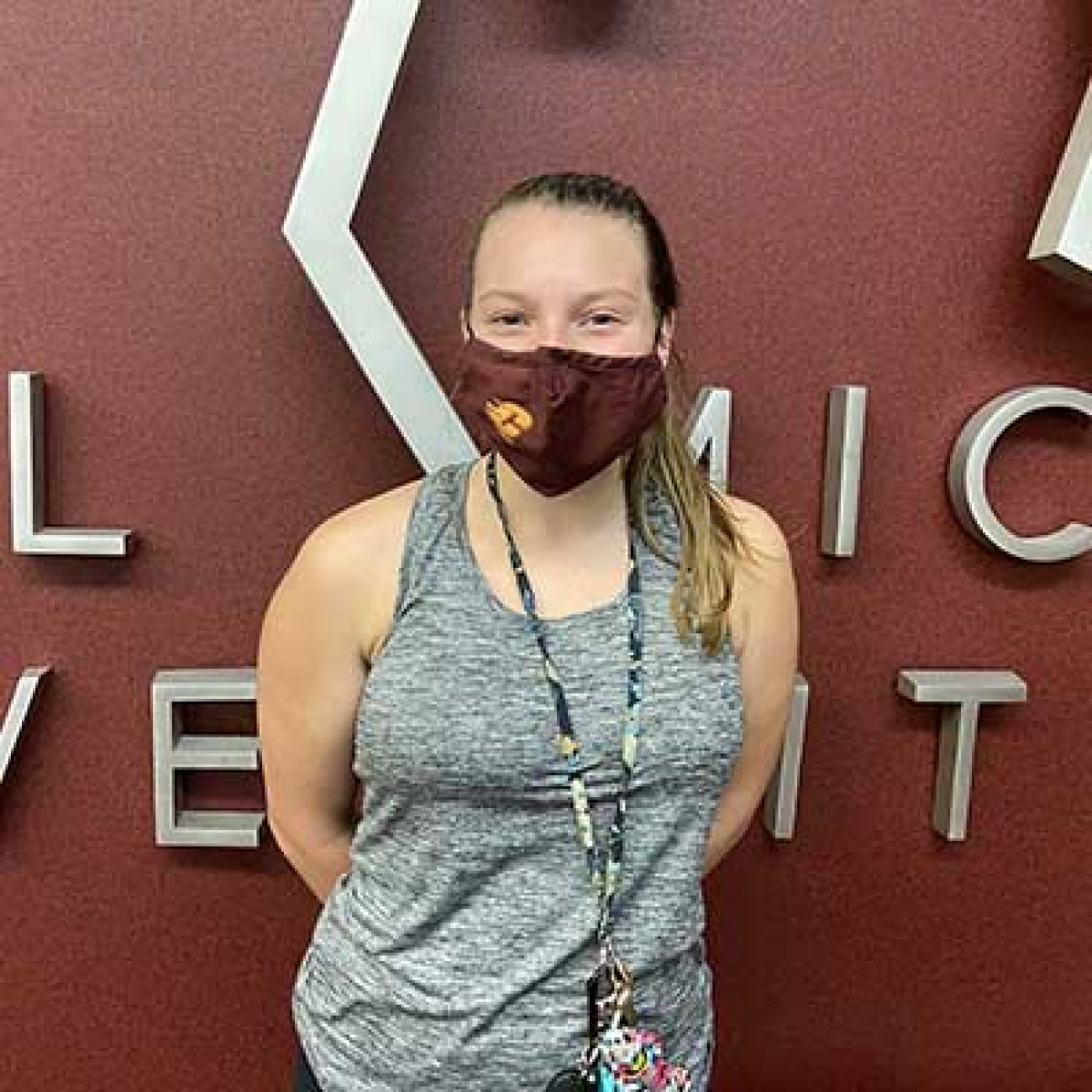Michigan college COVID outbreaks plummet as students vaccinate and mask up

Nov. 4: Biden mandate means 2 million Michigan workers must get COVID vaccine
Oct. 22: Where to get COVID vaccine boosters in Michigan
Oct. 18: Michigan business leaders ask President Biden to reconsider vaccine mandate
Central Michigan University student Maddie Clark said she was hesitant to get a COVID-19 vaccination last spring when she first became eligible.
Then this summer, she learned CMU was giving students a choice for the fall semester: get vaccinated, or get a cotton swab up your nose once a week for testing.
When the senior returned to the Mount Pleasant campus in August, she headed straight to Walgreens.
Related:
- COVID vaccine boosters: When, where and how to get them in Michigan
- After 18 months: Welcome back, Canada, if you’re vaccinated
- Michigan ER patients left on stretchers, then recliners, in swamped wards
- Amid controversies, U-M President Mark Schlissel announces 2023 departure
- Michigan universities limit dining options, citing worker shortage
- Education levels drive Michigan vaccines. What’s rate in your neighborhood?
“I got my first dose my first day I came back,” said Clark, of Ypsilanti. “Coming back to school, being around a bunch of people, I thought it was time.”
A year ago, CMU and many other Michigan colleges were scenes of large coronavirus outbreaks, leading to public health emergencies and campus-wide quarantines of tens of thousands of students. Michigan State University closed most of its dorm rooms for fall 2020 and virtually all classes at many colleges and universities were held online.
This year, outbreaks have dropped precipitously and college campuses in Michigan are often safer from COVID than their surrounding communities. Some have strict vaccine mandates, including at the state’s two largest university campuses: Michigan State University and the University of Michigan. Others, like CMU, give students a jab-or-test choice.
Almost all have enacted — with little signs of protest — mask requirements inside campus buildings (other than dorm rooms) that have proven so controversial in the state’s K-12 schools.
State data shows the pandemic safety measures appear to be working.
A year ago, in the first week of October, months before the first vaccines were approved in the U.S., there were 4,902 new or ongoing cases of COVID-19 connected to outbreaks at Michigan colleges and universities. Now, there are just 445 — an 11-fold plummet.
With a mix of incentives and mandates, many Michigan colleges now have high vaccination rates. At U-M, where vaccinations are mandated this school year for students, faculty and staff, 96 percent of students have had their shots.
At MSU, 90 percent of students are vaccinated.
The uncontrolled spread of the virus also is down dramatically. The rate of students who test positive for COVID-19 is just above 1 percent at U-M and MSU, and half that at CMU. All are in counties in which the test positivity rate is five to 10 times higher than on campus.
Statewide, the positivity rate of COVID-19 tests over the past week is 11.2 percent.
Those data points are “a very good sign of what’s happening on campus,” said Linda Vail, Ingham County health officer, whose jurisdiction includes MSU. “We’re in a completely different place than we were a year ago.”
COVID rates up in K-12 schools
While infections among college students nosedived this fall, reported COVID cases in Michigan’s K-12 schools have skyrocketed compared to this time last year, though they still represent a tiny sliver of the state’s 1.4 million public school students.
There were 343 new or ongoing COVID cases tied to outbreaks in pre-K and K-12 schools 12 months ago. As of Monday, there were 3,021 cases tied to outbreaks, according to state health data.
Part of that almost nine-fold increase can be attributed to the fact that far more K-12 students are physically in classrooms this fall. In September of last year, 36 percent to 57 percent of students were in classrooms, compared to nearly all Michigan students in classrooms this fall.
Still, the contrast between the rising numbers in K-12 schools and the declines at universities brings into stark relief the differences in mitigation efforts.
Mask and vaccine requirements are inconsistent for children and adolescents, for a host of reasons.
Masks are mandated for about 60 percent of students in the state’s K-12 schools, with decisions made (and increasingly, reversed) at the local level; And as Bridge Michigan has reported, among the 40 percent of students in districts where masks are optional, few wear them.
In addition, elementary-age children are not yet eligible to receive COVID-19 vaccinations and, statewide, just 37 percent of youths aged 12-15 are fully vaccinated, a rate far below college-age students.
In areas of the state where young teens have higher vaccination rates, case rates have been lower, a Bridge Michigan analysis of state vaccine and case data shows.
Conversely, the three regions with the lowest vaccine rates among eligible youth — the Upper Peninsula, south-central Michigan and the Thumb and Lake Huron shoreline — have the highest youth case rates.
The south-central region of Jackson, Lenawee and Hillsdale counties has seen just over 25 percent of eligible 12-15 year olds get vaccinated so far, the lowest of the eight regions of the state.
In the four weeks ending Sept. 28, state data shows this region had 16,773 cases of COVID-19 for every 1 million youths aged 12 to 15. That’s 48 percent higher than the average rate of the three regions with the highest vaccination rate of about 39 percent.
The metro Detroit region had the second highest youth vaccination rate of 38 percent and the lowest case rate: 9,121 cases per 1 million.
The Detroit region includes Washtenaw County, where 65 percent of 12- to 15-year-olds are vaccinated. Susan Ringler-Cerniglia, spokesperson for Washtenaw’s health department, said parents there were ready to get their kids vaccinated.
“I’d like to think we had something to do with it,” said Ringler-Cerniglia. “But certainly there was a lot of interest for participation in that particular age group.”
Washtenaw County is home to two large universities (U-M’s Ann Arbor campus and Eastern Michigan University in Ypsilanti) and has a high percentage of adults with college degrees. As Bridge has also reported, there is a strong relationship between education and vaccination levels, with those with higher levels of education far more likely to seek one of three U.S.-approved coronavirus vaccines.
Vax exemptions the college exception
MSU, U-M, Grand Valley State University and Oakland University have firm vaccination mandates for students, staff and faculty.
All four campuses offer exemptions for those who cite and qualify for health or religious objections to getting vaccinated. For example, at Grand Valley, while 83 percent of students are vaccinated, 10 percent have exemptions and the remainder (about 1-in-14 current students) are out of compliance and could eventually face some form of discipline.
At Oakland, 79 percent of students who take at least one class on campus are vaccinated, 9 percent have exemptions, and 12 percent are not yet compliant.
What discipline could look like for students, staff and faculty at MSU who decline to get vaccinated or request an exemption will likely vary, said spokesperson Emily Guerrant, but could end in termination for employers or expulsion for students.
“Earlier this week, we started some of the termination processes for just a handful (of employees),” Guerrant said. “For students, that process takes longer. If they indicate they are absolutely not going to get it, they will be referred to the dean of students.”
At MSU, about 4,200 students and employees out of a total of 68,000 applied for exemptions, with “a couple hundred” requests rejected, Guerrant said.
Alma College, a private liberal arts school, is among the institutions that offers students a choice of vaccination or regular testing. There, 77 percent of the school’s 1,400 students are vaccinated, while the rest get tested twice a week.
“We’ve tried to make the testing not be a punishment, we want this to be a student choice,” Alan Gatlin, Alma’s chief operating officer, told Bridge Michigan.
One reason Alma students get vaccinated, according to Gatlin, boils down to a difference in quarantine policies set by the Central Michigan District Health Department, which covers Isabella County where CMU is located. Students who’ve had close contact with someone who tests positive don’t have to quarantine if they’ve been vaccinated, while the unvaccinated do.
“That’s a big incentive,” Gatlin said.
“Our students have been great,” Gatlin said. “They all want a real college experience, and most feel like, in the times we’re in, this is a fair trade-off.”
The results of these pandemic trade-offs are a more normal school year, with far fewer infections and quarantines. At U-M, for example, there were 53 new confirmed cases in the most recent week of data, compared to 221 in the same week a year ago when vaccines were not yet available, according to the university’s COVID data web page.
Western Michigan University, where 73 percent of students are at least partially vaccinated, is averaging fewer than three new positive cases per day on a campus with 16,000 undergraduates.

CMU has more than doubled its share of students who are vaccinated since mid-August, from 33 percent to 73 percent.
One of the roughly 3,000 CMU students who have opted for routine testing rather than vaccination is Erika Cheney, a CMU sophomore from Jackson.
“I like being given the option rather than being forced to do something against my will,” said Cheney, after getting her weekly test Monday.
“I am not anti-vax, I don't want people to get the wrong impression. I just feel there should be more study on the vaccine, and so I'm more comfortable with just getting tested.”
Makayla Coffee contributed to this report.
Michigan Education Watch
Michigan Education Watch is made possible by generous financial support from:
Subscribe to Michigan Education Watch
See what new members are saying about why they donated to Bridge Michigan:
- “In order for this information to be accurate and unbiased it must be underwritten by its readers, not by special interests.” - Larry S.
- “Not many other media sources report on the topics Bridge does.” - Susan B.
- “Your journalism is outstanding and rare these days.” - Mark S.
If you want to ensure the future of nonpartisan, nonprofit Michigan journalism, please become a member today. You, too, will be asked why you donated and maybe we'll feature your quote next time!






